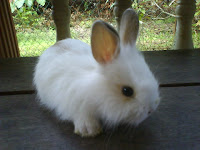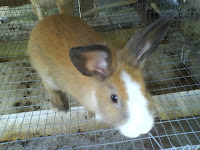Rabbit Zone
rabbits for sale...
Saturday, 4 August 2012
Rabbit Grooming
Rabbits need to have their nails clipped short so they do not get caught on the wire cage or scratch their owners arms. Rabbits have 4 different types of fur, normal, rex, satin and wool. Normal fur has a dense undercoat with coarse guard hairs extending past the undercoat. Rex fur is denser than normal fur and the guard hairs are about the same length as the undercoat. Rex fur stands up perpendicular to the skin, giving it a unique feel. Satin fur is fine and has a hair shaft that reflects light, giving it a spectacular sheen. Wool is found on Angora rabbits. There are actually four different types of wool found on different types of Angoras. A lot of rabbit owners with Angora coats choose to keep their coats cut short for easier care. Angora fur should not be clipped right up to the skin as the coat provides natural protection against heat, cold, and anything that may injure the skin. Be sure to leave at least 1 inch (2.5 cm) in length to the coat. Rabbits, like cats will groom themselves, however in doing so they are prone to hair balls. Brushing your rabbit at least once a week will reduce the chances of hairballs. Angora rabbits with full coats will have to be brushed more frequently. Brushing should be done more frequently during shedding season. Rabbits shed about every three months. Be sure to only use a brush or comb that will not hurt the rabbits delicate skin. Do not trim the hair on the rabbits hocks and back feet or it may cause hock sores. Rabbits generally do not need to be bathed. If your rabbit is dirty in only one area only wash that area as bathing a rabbit can be very stressful for the bunny. Check ears regularly for waxy buildup or debris. Rabbit ear cleaner solution can be purchased from your vet. Dark build up can be a sign of ear mites. Lop eared rabbits are more prone to ear problems. Like dogs and cats, rabbits can get fleas. If your rabbit gets fleas contact your vet for the best way to eliminate the itchy bugs from their fur.
Rabbits As Pets
Domestic rabbits can be kept as pets in a back yard hutch or indoors in a cage or house trained to have free roam. Rabbits kept indoors are often referred to as house rabbits. House rabbits typically have an indoor pen or cage and a rabbit-safe place to run and exercise, such as an exercise pen, living room or family room. Rabbits can be trained to use a litter box and some can learn to come when called. Domestic rabbits that do not live indoors can also serve as companions for their owners, typically living in a protected hutch outdoors. Some pet rabbits live in outside hutches during the day for the benefit of fresh air and natural daylight and are brought inside at night.
Whether indoor or outdoor, pet rabbits' pens are often equipped with enrichment activities such as shelves, tunnels, balls, and other toys. Pet rabbits are often provided additional space in which to get exercise, simulating the open space a rabbit would traverse in the wild. Exercise pens or lawn pens are often used to provide a safe place for rabbits to run.
A pet rabbit's diet typically consists of unlimited timothy-grass or other hay, a small amount of pellets, and a fair quantity of fresh vegetables and need unrestricted access to fresh clean water. Rabbits are social animals. Rabbits as pets can find their companionship with a variety of creatures, including humans, other rabbits, birds, chinchillas, guinea pigs, and sometimes even cats and dogs (however they require supervision when with dogs and cats, as they might be preyed upon or attacked by these animals). Rabbits can make good pets for younger children when proper parental supervision is provided. As prey animals, rabbits are alert, timid creatures that startle fairly easily. They have fragile bones, especially in their backs, that require support on the belly and bottom when picked up. Older children and teenagers usually have the maturity required to care for a rabbit.
Rabbit's Diet And Eating Habits
Diet and eating habits
Rabbits are herbivores that feed by grazing on grass, forbs, and leafy weeds. In consequence, their diet contains large amounts of cellulose, which is hard to digest. Rabbits solve this problem by passing two distinct types of feces: hard droppings and soft black viscous pellets, the latter of which are immediately eaten. Rabbits reingest their own droppings (rather than chewing the cud as do cows and many other herbivores) to digest their food further and extract sufficient nutrients
Rabbits graze heavily and rapidly for roughly the first half hour of a grazing period (usually in the late afternoon), followed by about half an hour of more selective feeding. In this time, the rabbit will also excrete many hard fecal pellets, being waste pellets that will not be reingested. If the environment is relatively non-threatening, the rabbit will remain outdoors for many hours, grazing at intervals. While out of the burrow, the rabbit will occasionally reingest its soft, partially digested pellets; this is rarely observed, since the pellets are reingested as they are produced. Reingestion is most common within the burrow between 8 o'clock in the morning and 5 o'clock in the evening, being carried out intermittently within that period.
Hard pellets are made up of hay-like fragments of plant cuticle and stalk, being the final waste product after redigestion of soft pellets. These are only released outside the burrow and are not reingested. Soft pellets are usually produced several hours after grazing, after the hard pellets have all been excreted. They are made up of micro-organisms and undigested plant cell walls.
The chewed plant material collects in the large cecum, a secondary chamber between the large and small intestine containing large quantities of symbiotic bacteria that help with the digestion of cellulose and also produce certain B vitamins. The pellets are about 56% bacteria by dry weight, largely accounting for the pellets being 24.4% protein on average. These pellets remain intact for up to six hours in the stomach; the bacteria within continue to digest the plant carbohydrates. The soft feces form here and contain up to five times the vitamins of hard feces. After being excreted, they are eaten whole by the rabbit and redigested in a special part of the stomach. This double-digestion process enables rabbits to use nutrients that they may have missed during the first passage through the gut, as well as the nutrients formed by the microbial activity and thus ensures that maximum nutrition is derived from the food they eat. This process serves the same purpose within the rabbit as rumination does in cattle and sheep.
Rabbits are incapable of vomiting.
Sunday, 6 May 2012
Friday, 20 April 2012
RABBIT FACTS...
Rabbits sold at pet shops are basically a month old or more. Those rabbits will look the cutest and most fluffy but the reality is those rabbits does not have proof for what true breed it is or its quality..
I'm producing rabbits that anyone can be certain of its quality. Take a look at pic (A) its a a month old rabbit that is produced at my farm, pic (B) is the same rabbit at the age of 3 months old.. So this article is to proof the quality of rabbits i produce and to educate all my blog visitors to not get fooled by irresponsible people that cheats to sell whatever stock they have..
 |
| pic (A) |
 |
| pic (B) |
Rabbits sold at pet shops are basically a month old or more. Those rabbits will look the cutest and most fluffy but the reality is those rabbits does not have proof for what true breed it is or its quality..
I'm producing rabbits that anyone can be certain of its quality. Take a look at pic (A) its a a month old rabbit that is produced at my farm, pic (B) is the same rabbit at the age of 3 months old.. So this article is to proof the quality of rabbits i produce and to educate all my blog visitors to not get fooled by irresponsible people that cheats to sell whatever stock they have..
Thursday, 19 April 2012
NEW BORNS AVALABLE FOR SALE...
These cute bunnies will be available for sale in another 25 days... So if interested book fast..
price will be determined when its available for sale.. call or sms at 0173694649- nishan
These are female netherland dwarf rabbits age a month+ for sale..
Anyone interested to find their male rabbit a pair please call my number above..


These cute bunnies will be available for sale in another 25 days... So if interested book fast..
price will be determined when its available for sale.. call or sms at 0173694649- nishan
Anyone interested to find their male rabbit a pair please call my number above..
 |
| netherland dwarf, price: RM 70 |

 |
| Netherland Dwarf, price: RM 70 |

Sunday, 15 April 2012
LIONHEAD RABBITS
No matter how the Lionhead rabbits began, I think most people will agree they are adorable.
They may be different versions on the origination of these bunnies but one thing is for sure, is that a Lionhead bunny is a mutation. And whoever started this breed the outcome is wonderful.
There are two different versions of this breed, a European and the United States. The European breed is a crossbred between a Swiss Fox, Belgian Dwarf and a small woolly breed. They have also added a lop eared Lionhead along with the erect eared.
The United States breed was imported from Europe, and then it was crossbred with different smaller breeds to improve the breed. In 2005, the Lionhead was finally recognized by the ARBA, but only in the tortoise color.
Since this is a relative new breed, and there are so many different colors the ARBA is taking time to prepare this breed for acceptance.
These rabbits are known to be a friendly bunny and they enjoy human contact. They will make wonderful house rabbit.
Since they have a woolly gene, brushing is a definite weekly routine for these pets. You will also need to check their little bunny bottoms to make sure they are kept clean. With the extra fur sometimes they need human help with the cleaning.
Subscribe to:
Comments (Atom)














